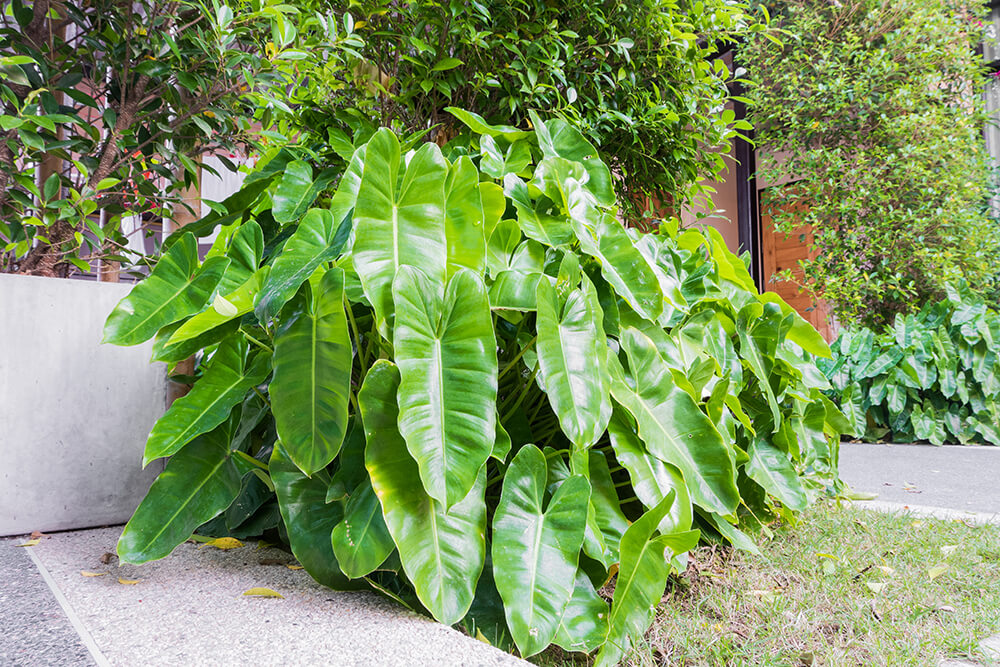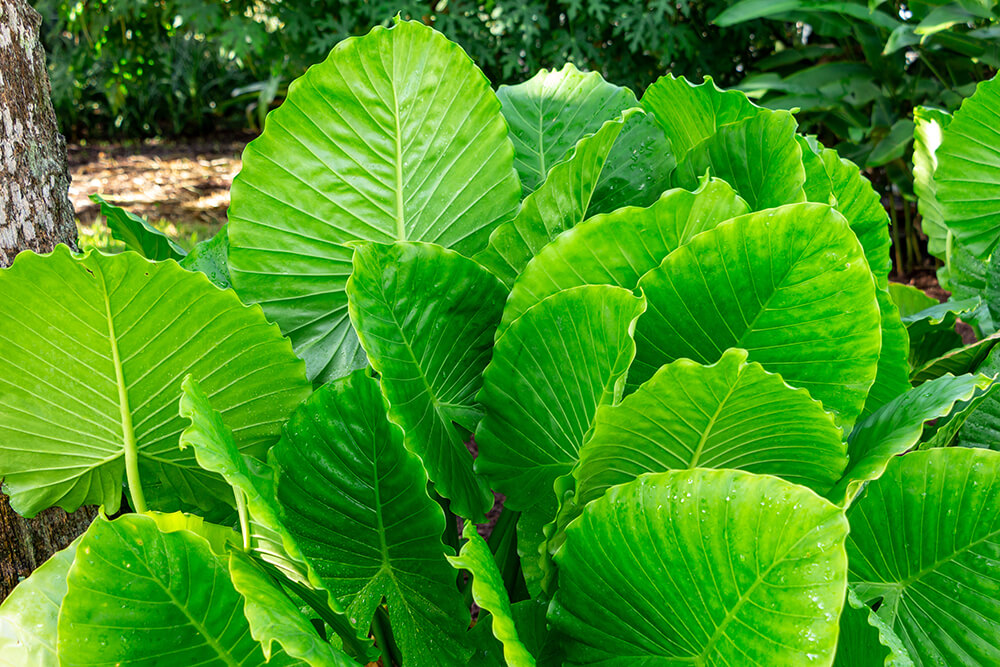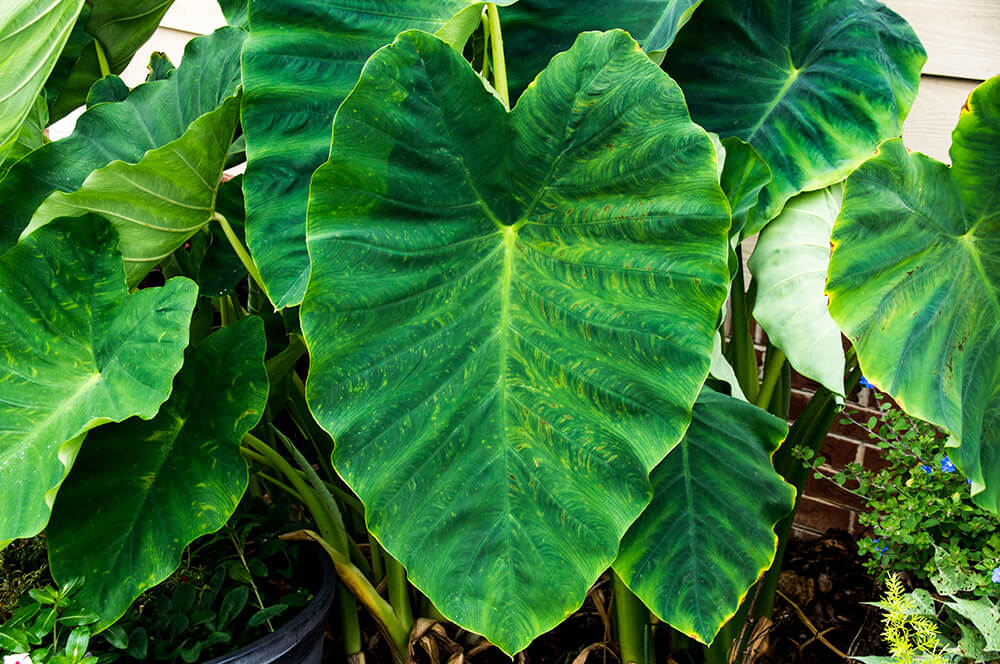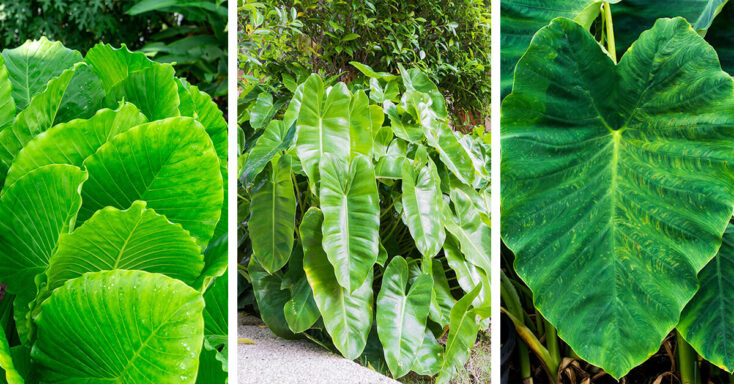Elephant Ear plants go by the scientific name of Alocasia. If you’re looking for a stunning piece for your outdoor garden, look no further. Why the name? Because the huge, heart-shaped leaves look like an (wait for it) elephant. Elephant ear brings a tropical touch to your outdoor garden. Better still, growing and caring for outdoor elephant ear plants is not difficult.
Key Takeaways
- Elephant Ear plants became popular because they bloom for nearly half the year and are very easy to grow.
- Warning: Elephant ear is toxic to pets and children in the uncooked state.
- When you first plant an elephant ear, it will need more water than when it’s mature.
- Many elephant ears are perennials. You can harvest them at any time of year without harm.
- You can grow elephant ears as an aquatic plant.
Enchanting Elephant Ear Plants
Other names for elephant ear varieties include remusatia and xanthosoma. You can find them in greenhouses worldwide. The species boasts over 3,000 plant types.
The natural habitat of elephant ears is tropical and lush, with plants of all sizes. It was most likely introduced to Africa by way of Portuguese traders in the late 1400s. It remains a staple in southern Africa to this day.
In holistic medicine kits, the elephant ear is part of a poultice for infected areas on your body. If you cut the leaf from this plant, you can rub it on insect stings to deter pain and swelling. Young elephant ear leaves have high Vitamin B1, B2, and C levels.
My, What Big Ears You Have: The first thing you notice about elephant ear plants is their enormous leaves. There’s no question they’re eye-catching. Some leaves can grow up to six feet long. That’s a lot of plant “real estate,” meaning you need to plan your garden accordingly.
Everything You Need to Know about Elephant Ear Plant Care
The Elephant Ear is not an overly complex plant. The care it requires is pretty straightforward.
- Moisture. Since they come from the rainforest, it’s no surprise they require a constant water supply. Keep your plant’s soil moist.
- Acidic Soil. If your yard doesn’t have enough acid, you can find remedials at the greenhouse store. Also, elephant ears benefit from hummus for moisture.
- Planting: Wait until there is no chance for the temperature to drop below 45 degrees before you put down a new plant.
- Tend to old leaves by simply pulling them off. This provides room for new growth.
- Winterizing: If your weather is such that it would harm your outdoor elephant ear, dig it up for the winter, and put it somewhere warm until spring.
- Feed your elephant ear with an all-purpose (10-10-10) fertilizer once a month.
- Lighting: Design your landscape so the elephant ear receives partial sun. If you have a darker cultivar, it needs slightly more sunlight, or it will fade.
The easiest way of propagating an elephant ear plant is through division. These plants have rhizomes. You can separate the plant into sections and then put each in a separate pot for brand-new babies.
General Needs for Outdoor Elephant Ear Plants
Elephant ear plants are fairly accommodating. If you put your species in the amount of proper sunlight, offer regular watering, and give it fertilizer, they’ll be just fine, especially if you live in USDA Hardiness zones 9-11. If you live in any of these zones, your elephant ear can remain outdoors year-round. Don’t panic if you see some yellow leaves. This is a natural effect of dormancy.
One word of caution: unless you want a ton of Elephant Ears in your garden, use a large planter for them. Outdoors they’re like mint and spread rapidly if not managed.

Planting Pointers If you have to store your elephant ears indoors, make sure they remain in an area with good ventilation. This prevents fungal growth. When you’re ready to plant, keep it close to the surface. Space your plants 4-feet apart. You’ll see growth in about three weeks. It takes 5-10 months for elephant ears to reach maturity.
Eying Elephant Ears for Your Home
While it’s common to envision elephant ear plants as deep green, some cultivars have variegated leaves and distinct color patterns.
- Black Coral: Grows to a manageable 4-feet tall. It features mesmerizing all-black, glossy leaves.
- Black Magic: Grows between 3-6 feet tall. It has notoriety as being the first black color (purple-black) with green undertones.
- Blue Hawaii: This plant grows 12” long leaves. The highlight of the show is the purple veins in this plant. They’re distinct and dramatic. Mature size 30 inches.
- Burgundy Stem: Grows to 80 inches tall with purple-cast leaves. When they flower, the blossoms are 1’ tall and smell fruity.
- Coal Miner: The leaves of this plant look smoky. Healthy plants grow to be 4-5 feet in height.
- Coffee Cups: A delightful plant that grows to be between 36 and 60 inches. What sets this elephant ear apart is the leaves cup in such a manner that they hold water.
- Diamond Head: The diamond head’s glossy purple leaves look crinkly, like unironed clothing. They grow to be 3-4 feet tall.
- Elena: Elena is not shy. It has flouncy lettuce-green leaves. Where they attach to the stalk, the veins are purple. Mature height 3-6 feet.
- Fontanesil: Also known as the Black Stemmed Elephant Ear. Mature growth 5-6 feet tall. The leaves are blue green and shaped like a heart. They point downward toward the soil. The stalks are dark blue-black.
- Hilo Beauty: Hilo has leaves that have markings like flicks from a painter’s brush. Mature height 2-feet. It’s a member of the philodendron family.
- Illustris: This elephant ear has very dark, flat green leaves. Depending on the light, they might look a little purple. If you like drama, you’ll love this elephant’s ear. The deep purple-to-black background has green veins! Height: 30-60 inches.
- Lime Zinger: The lime zinger’s claim to fame is 18’ long chartreuse green leaves. The arrows grow between 3-4 feet long. You’ll see the best colors on the Lime zinger first thing in the morning.
- Mojito: Where Hilo Beauty had pale green splotches, the Mojito has irregular black. speckles and splotches. Mature height 36”.
- Nancy’s Revenge. This is a tall elephant ear, some 80 inches. Nancy has a secret. At first, it has light green leaves. But as the season moves on, the center turns yellow, following the central vein downward. This is the time at which it flowers.
- Pink China: Rich green leaves adorn brilliant pink stems. At the center of each leaf, you’ll find a pink dot. It grows about 4 feet tall and is a fast spreader.
- Stingray: An odd-looking elephant ear. The leaves of this plant have distinct textures and a long tail (thus the name). Mature height 3-5 feet.
- Thailand Giant: This elephant ear earns its name with gray-green leaves some 5 feet long and 4 feet wide.
While elephant ears are well suited to outdoor cultivation, they can flourish inside the home. Look to the smaller varieties for a splashy statement piece for your indoor garden.
Watering Techniques
Did you know that elephant ear plants cry? This is how they let you know there’s too much watering happening. There is such a thing as “too much,” even with swamp and aquatic plants. Let the soil dry out initially, then monitor your future watering schedule.
Watering plays a crucial role in elephant ear growth. The right combination of water and nutrients brings out larger ears. As such, adding Elephant Ear to your water feature fits in perfectly. The plant requires a container with soil covered in pea gravel in this setting. Put the elephant’s ear in at an angle, watching for bubbles escaping. Do not completely immerse them, however.
Wildlife Haven: Your Elephant Ear plant is beauteous by itself. Add birds and butterflies, and your yard turns into a paradise. Set up a chair, take a book, and relax!
Potting and Repotting Elephant Ear Plants

You are not so much potting as you are transferring the plant from its greenhouse container into your yard plan. Look for an area with indirect sunlight that can accommodate your elephant ear’s mature size. These plants require 3-6 hours of sun exposure daily.
There’s a tricky balancing act with these plants. They will turn yellow when they don’t get enough sun. You find a sunnier location, and you have to water it more. Ah, but not too much! Moisture retention differs from drowning the plant. You can avoid some of the guesswork if you have a spot in your yard with swampy qualities and good drainage. Now, how do you know about drainage? Dig a 1-foot deep hole in the area where you’re considering putting the plant. Fill it with water, and check it in 4 hours. If you still see water, you have bad drainage.
Space elephant ears out about 3 feet apart. If you are concerned about spreading, there are clumping varieties you can get. Wait to put these in the ground when the temperatures won’t dip below 50F. Ideally, wait for 70F weather.
Prepare a hole 3 times larger than the bulb. Look for the part of the plant with concentric circles. That is the top. The flat goes firmly in the soil. Cover it completely and water it well.
If you want to jump-start the process, you can plant your bulbs inside a few weeks before spring.
In the South Pacific, elephant ear stalks are akin to everyman’s potato. People peel and cut the stalks for stir fry and soup. It is essential to cook elephant ears as it is poisonous raw.
Elephant Ear Pruning and Maintenance
Elephant ears grow quickly. Regular pruning not only maintains the plant’s shape but deters overgrowth. As the plant ages and leaves droop or become yellow-brown, you can cut them off. They are just drawing energy away from the rest of the healthy plant. This goes for spent flowers, too.
The best time to maintain your elephant ear is in early spring before the plant begins new growth. Cut the leaves back to the length desired. Don’t go crazy; some elephant ears won’t regrow if you cut back too far or damage the main plant.
If frost is on the horizon, prune down your plant to the base. Leave 6-12 inches above the ground. Cut the leaves where they meet the stem.
There are several benefits to regular pruning. First, it prevents seed pot formation, which isn’t visually pleasing. Pruning provides better air circulation, protecting the plant from fungal diseases. Then there’s sunlight. When you cut back leaves, you expose the plant to more sunlight. If all that isn’t enough, pruning gives your plant strength to grow more robust leaves and roots, which, in turn, improves nutrient absorption.
Caution: Wear gloves when maintaining your elephant ear plant. The sap causes skin irritation in some people. Clean off your tools, too.
Outdoor Elephant Ear Plant Blooming and Resting Periods

Elephant ear plants need a rest period come winter. Let the soil become nearly dry. If you let it die completely, it will become dormant. For protection, you can dig up the tubers before the threat of frost, placing them in a cool, indoor location. Let the roots dry out some, wrap them in paper, and put them in a safe place. It’s wise to check the plants periodically in case they mold or rot. Replant in spring.
You can expect flowers from late spring to early fall. The blossoms are called spathes. Colors range from creamy white to yellow and light green.
Elephant ears will happily take over as much space as you let them. One variety clumps, Colocasia, is far more manageable. Additionally, create a distinct edge between elephant ears and the rest of your plants. Potting is most definitely one solution.
Common Pests & Plant Diseases Found in Outdoor Elephant Ear Plants
At the top of the list for disease is fungal leaf blight. You can treat this if you catch it in time. Look for lesions that turn purple and ooze. You may also see something that looks like fuzz on the leaves. Remove the affected leaves. Consider an anti-fungal treatment.
Another issue is pythium rot. This rot may begin when the plant’s soil remains saturated for extended periods. You will notice yellow patches on the leaves and stems. If you uproot the plant, you’ll see a greasy mess. Sadly, you cannot save your plant.
From the insect kingdom, spider mites arrive. They like the shady, textured leaves. They may be large enough for you to capture a glance, appearing as brown spots. As they go, they leave their signature mark, little webs. Spider mites aren’t tough fellows. Give the plant a good hosing to wash the pests away. Follow with insecticidal soap.
Seed Production: A commonly asked question about elephant ears is, do they grow seeds? The answer is yes. Older plants will eventually produce seed pods. As soon as you see one, check to see if it’s dry (a sign of maturation.) Harvest it. For new plants, sow the seeds quickly as they have a short shelf life.
Troubleshooting Elephant Ear Plant Problems
Elephant ears aren’t overly susceptible to many issues. Nonetheless, certain problems may arise.
- Drooping Leaves: Large leaves droop if they become too heavy. Offer stake support. Alternatively, your plant may need adjustments in light and water levels.
- Pale Leaves: Provide your plant with more nutrients and water.
- Yellow Leaves: This is one of those moments where if it’s not one thing, it’s another. Yellow leaves develop because of too much (or too little) light, water, or fertilizer. Your plant might yellow when it’s going dormant, too.
- Wilting: Either the elephant ear plant is too hot or getting too much sun. It will probably need a boost of water.
If you like the appearance of elephant ears but don’t want to worry about invasiveness, there are other options. Look at the banana plants, Jack in the Pulpit, Buttonbush, pickerelweed, and scarlet hibiscus as alternatives.
Frequently Asked Questions About Elephant Ear Care and Keeping
Do elephant ear plants need sun or shade?
A little of both, please. The only varieties that do well in full sun are plants with dark-colored leaves to keep them from fading. The ideal situation would be a spot in your yard where the plant would receive morning sunlight, followed by shady afternoons.
How much sun do elephant ears need?
Make sure your elephant ear plant receives at least six hours of sun daily. Two hours of direct sunlight (no more) support growth, too.
How do you take care of an elephant ear plant indoors?
If you choose to bring elephant ear plants into your home, begin by assessing your space. Buy a cultivar suitable to the area you have available. Placing the plant in a western window allows for partial sun. If your home stays between 60 and 80F, that’s a perfect temperature. If you have a small humidifier, put it near the elephant's ear for humidity. Mist your plant regularly.
How often should you water an elephant ear plant?
Some plants like it wet, wet, wet. Others require dry soil. The Elephant Ear plant lands firmly between the two. If your leaves look droopy or start wilting, it needs more water. Once you provide hydration, the elephant ear perks right up. Note that newly cultivated plant requires daily watering for two weeks. Remain mindful of the weather. If you get a lot of rain, don’t water. When it’s hot and dry, increase your watering schedule.
Can elephant ears be overwatered?
Being a swampy plant, you can overwater elephant ears. However, as soon as you notice the problem, let your plant dry out. One sign is yellowing leaves. Water elephant ear plants in the morning before the heat of the day.
Summary
Elephant Ear plants are things of grandeur. Their stunning, large leaves cover areas of landscape you might wish to hide or where the garden is bare. There are three things you will need to monitor in outdoor elephant ears in terms of growing, care, and ongoing maintenance: water, sun, and fertilizer. Once you’ve mastered them, sit back and enjoy the view.


